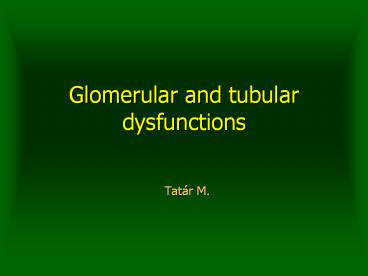Glomerular and tubular dysfunctions PowerPoint PPT Presentation
1 / 34
Title: Glomerular and tubular dysfunctions
1
Glomerular and tubular dysfunctions
- Tatár M.
2
Basic kidney functions
- Water and electrolyte homeostasis
- Acid base balance
- Elimination of waste products and ingested
chemicals - Hormone production
3
(No Transcript)
4
Mechanisms of renal excretion
- 180 l glomerular filtrate per day (2 ml/s)
- 99 - back reabsoption
- Renal perfusion at rest 20 of cardiac output
(this is higher than in heart, brain and liver
5
(No Transcript)
6
(No Transcript)
7
Glomerular filtration rate
- Balance of hydrostatic and osmotic pressures
acting across diffusion barrier (endotelium
fenestrae, basement nenbrane, slit diaphragms
betweens the podocytes) - Factors determining GFR
- Surface area (1 milion nephrons within each
kidney) - Permeability
- Net filtration pressure (NFP) across diffusion
barrier
8
Factors determining GFR
surface area permeability
filtration koefficient (Kf)
GFR Kf x NFP
NFP PGC PT ?GC
24 60 - 15 - 21 mmHg
9
(No Transcript)
10
Disturbances of glomerular function (1)
- Decrease of glomerular filtration
- ? renal blood flow
- stenosis of renal artery
- ? glomerular capillary hydrostatic pressure (PGC)
- hypovolemia, circulatory shock
- ? hydrostatic pressure in Bowmans capsule (PT)
- block of fluid flow ( intra- and extrarenal)
- ? concentration of plasma proteins (?GC)
- ? Kf
- ? effective filtration surface area
11
Disturbances of glomerular function (2)
- B. Increase of glomerular permeability
- Proteinuria
- Glomerular proteinuria
- Size-selective properties of the glomerulus
- Charge-selective propeties of the glomerulus
- Hamodynamic forces operating across the
glomerulus
12
(No Transcript)
13
(No Transcript)
14
Glomerular proteinuria
- Selective proteinuria
- Albumin
- Small amount of low-molecular globulins
- Non-selective proteinuria
- Albumin
- Globulins of various molecular weight
15
Tubular reabsorption of proteins
16
Tubular proteinuria
- ? excretion of low molecular proteins
- ?1-microglobulin, ?2-microglobulin
17
Overload (prerenal) proteinuria
- Small molecular weight proteins can rise when are
synthetised in excess - Tissue degraded products
- Proteins of acute phase (pyretic proteinuria)
- Myoglobin (rhabdomyolysis)
- Ligfht immunoglobulin chains (myeloma)
18
Proteinuria
- Healthy adult subject
- No more than 150 mg/day
- Small proteinuria
- 1 g/day
- Haevy proteinuria
- 3,5 g/day and more
- Nephrotic syndrome (10 30 g/day)
19
Renal hematuria
- Glomerular
- Abnormally increased permeability
- Non-glomerular
- Rupture of tumor or cyst vessels
- Bleading from urinary tract
20
Relation between the reduction of GFR and
excretion function of kidneys
- ? GF ? ? retention of substrates
- 1. urea, creatinín
- 2. phosphates, K, H
- 3. NaCl
21
(No Transcript)
22
Tubular reabsorption and secretion
23
Active transport
24
Reabsorption of glucose, amino acids, Na, K, Cl,
H2O
Proximal tubule
Thick ascending limb of loop of Henle
Distale tubule
25
Disturbances of tubular functions
- Tubular proteinuria
- Glucosuria
- Aminoaciduria
- Diabetes insipidus
- Neurogenic (? ADH)
- Nephrogenic (insensitivity of the renal tubule to
ADH) - Osmotic diuresis
- Pressure of large quantities of unreabsorbed
solutes in the renal tubules ? increase in urine
volume - Unreabsorbed solutes in the proximal tubules
hold water in the next tubules
Transport maximum
26
Hydrogen ion secretion and bicarbonate
reabsorption
Renal tubular acidosis - impairment of the
ability to make the urine acidic - chronic
renal disease reduction of secreted hydrogen
ion because of impaired renal tubular
production of NH4
27
Loop of Henle and production of concentrated urine
- Permeability for water and NaCl - ADH
28
Counter-current exchange in the vasa recta
29
Disturbances of kidney ability to concentrate
urine
- Disturbances of water reabsorption
- - diabetes insipidus
- Disturbances of the production of medullar
hyperosmolarity - - osmotic diuresis
- - ? blood flow in vasa recta
- - morphologic deformations of medulla
30
Nephrotic syndrome
- Proteinuria 3.5 g or more of protein in the
urine per day - Minimal changes of glomerular membrane 90
albumin (selective proteinuria) - Hypoproteinemia (hypoalbuminemia)
- Mechanisms proteinuria
- Protein loss by stool
- Plasma proteins are shifted to extravascular
space - Increased albumin katabolism
- Inadequately increase albumin synthesis in liver
- Hyperlipidemia
- Incresed lipoprotein synthesis in liver
- Generalised edema
31
Mechanisms of edema in nephrotic syndrome (NS)
- Classis theory
- Hypoalbuminemia ? ? plasma oncotic pressure ?
hypovolemia ? R-A-A ADH ? Na water retention - !!! But hypovolemia is present only in 30 of
patients suffering from NS plasma renin activity
and aldosteron are decreased - Two groups of patients with NS
- Hypovolemia and ? R-A-A activity
- - small glomerular abnormalities
- Hypervolemia without R-A-A activation
- - more serious morphological abnormalities
32
Pathophysiology of edema formation
- Extracellular fluid volume is determined by the
balance between Na intake and its renal excretion - Common feature renal salt retention despite
progressive expaansion of ECF volume - Primary abnormality of the kidney
- Secondary response to some disturbances in the
circulation
33
Primary edema (overfill)
- Primary defect in renal sodium excretion
- Hyperevolemia leads to high cardiac output
- ? R-A-A, ? ADH, ? sympathetic activity
- Examples blomerulonephritis, renal failure
34
Secondary edema (underfill)
- Response of normal kidnay to actual or sensed
underfilling of the circulation - Primary disturbances within the circulation
secondary triggers renal sodium retention - ? R-A-A, ? ADH, ? sympathetic activity
- Effective arterial blood volume

